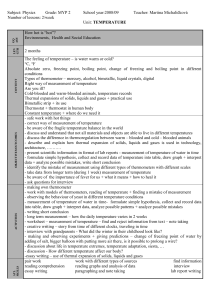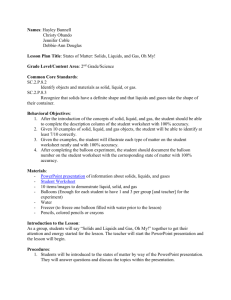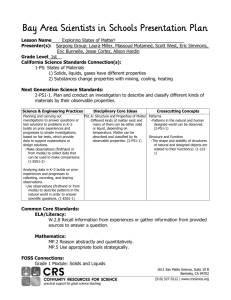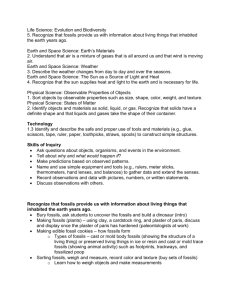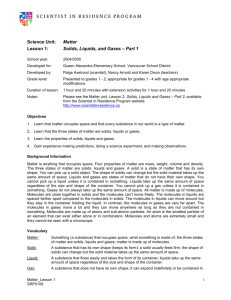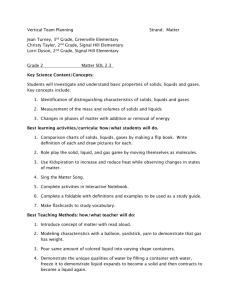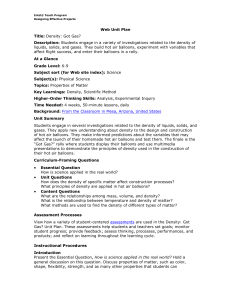fau lesson plan
advertisement
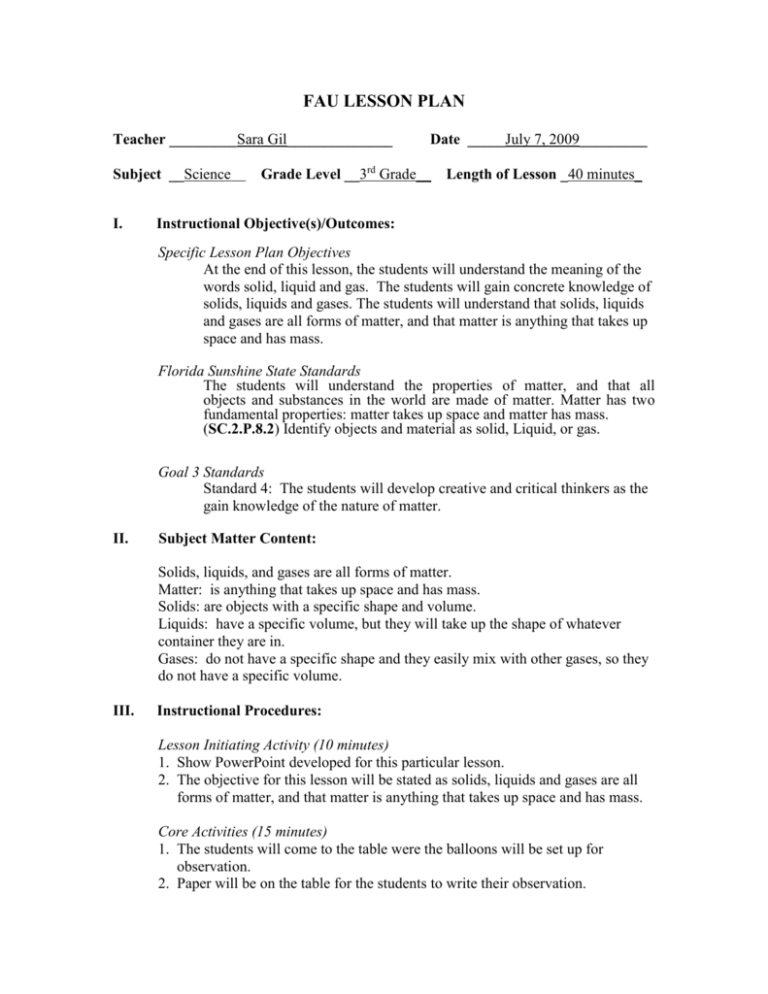
FAU LESSON PLAN Teacher _________Sara Gil______________ Subject __Science I. Date _____July 7, 2009_________ Grade Level __3rd Grade__ Length of Lesson _40 minutes_ Instructional Objective(s)/Outcomes: Specific Lesson Plan Objectives At the end of this lesson, the students will understand the meaning of the words solid, liquid and gas. The students will gain concrete knowledge of solids, liquids and gases. The students will understand that solids, liquids and gases are all forms of matter, and that matter is anything that takes up space and has mass. Florida Sunshine State Standards The students will understand the properties of matter, and that all objects and substances in the world are made of matter. Matter has two fundamental properties: matter takes up space and matter has mass. (SC.2.P.8.2) Identify objects and material as solid, Liquid, or gas. Goal 3 Standards Standard 4: The students will develop creative and critical thinkers as the gain knowledge of the nature of matter. II. Subject Matter Content: Solids, liquids, and gases are all forms of matter. Matter: is anything that takes up space and has mass. Solids: are objects with a specific shape and volume. Liquids: have a specific volume, but they will take up the shape of whatever container they are in. Gases: do not have a specific shape and they easily mix with other gases, so they do not have a specific volume. III. Instructional Procedures: Lesson Initiating Activity (10 minutes) 1. Show PowerPoint developed for this particular lesson. 2. The objective for this lesson will be stated as solids, liquids and gases are all forms of matter, and that matter is anything that takes up space and has mass. Core Activities (15 minutes) 1. The students will come to the table were the balloons will be set up for observation. 2. Paper will be on the table for the students to write their observation. 3. The students will be instructed to investigate the contents of the three balloons and write their observations and illustrate what they saw on paper. The students will feel the frozen balloon, cut the rubber off with scissors and discuss what they see and feel. The students will do the same with the water balloon, observing the properties of the water both when it is in the balloon and as they pour it into the dish or bowl. The student will feel the balloon filled with air, they will let air out and write their observations. 4. I will encourage use of descriptive words such as "hard, invisible, wet, splashy," etc. Closure Activities The student will go back to their seats and we will discuss all of their observation. The students will view an example of the state of matter through the use of the internet. On the white board I will have a chart with three heading of solid, liquid, and gas. The students will call out their ideas when called on and I will chart them on the board. Finally we will discuss the answers. Connection to other disciplines: Language Arts: Students will gain language arts knowledge through the completion of assignments and reading fluency through the diverse reading included in the assignments. Visual Arts: Students will gain visual arts knowledge through the illustration process involved in this lesson. Websites/Technology: The students will be introduced to power-point through teacher instruction and demonstration. Accommodations for ESE and ESOL: Students with special needs and limited English proficiency will be sitting upfront close to the teacher. The students will be paired with a buddy that can help them. The students will be given visual examples as oppose to all written materials. The students will be verbal instructions at all times and extra time to complete assignments. Further previsions will be made depending on the students IEP. Language facilitators will be asked to support teacher if needed. Gifted students will be asked to complete an online activity on the changes of matter if time allows. IV. Materials and Equipment: Water Balloons Scissors Paper towels Bowls White construction paper or copier paper Computer/internet access V. Assessment/Evaluation: Students will be assessed by their participation as well as completion of observation paper and illustration. VI. Follow-up Activities: The students will be asked to take turns on the computer and complete a web assisted activity. VII. Self Assessment: In order to answer the question the students may have it is my responsibility to complete the activity prior to introducing it to the students. Being prepared prior to the class discussion is vital. Researching the necessary knowledge regarding the subject being discussed is necessary. VIII. Resources: Stockman, -. C. (n.d.). What's In My Balloon? Science Lesson Plan, Thematic Unit, Activity, Worksheet, or Biology or Chemistry Teaching Idea. Retrieved July 25, 2009, http://www.lessonplanspage.com/ScienceSolidLiquidGasExploreWithBalloons2.htm States of Matter. (n.d.). Retrieved July 25, 2009, from http://www.media.pearson.com.au/schools/cw/au_sch_whalley_sf1_1/int/matter.htm States of Matter. (n.d.). Retrieved July 25, 2009, from http://www.harcourtschool.com Rubric: 4 - Words used to describe the experiment are very descriptive, well thought out and used properly. No spelling errors. Illustrations are drawn to the best of the student’s ability and colored neatly. 3 - Words used to describe the experiment are descriptive and used properly. Illustrations are drawn and detailed but not colored. 2 - Words used to describe the experiment are somewhat clear, shows some attempt at describing the experiment. Illustrations are drawn but are not relevant to the experiment. 1 - Words used to describe the experiment have little to do with the experiment. Shows little effort at describing the experiment. Illustration is below the Second Grade level. 0 - Words to describe the experiment have nothing to do with the experiment. Shows no effort whatsoever. No illustrations.


